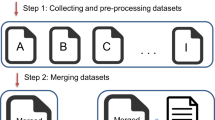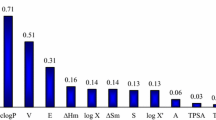Abstract
In the present study, adequate quantitative structure-activity relationship (QSAR) models were developed to analyze the water solubility of some ammonium hexafluorosilicates. All models were developed using structural descriptors calculated by the SiRMS method based on the simplex representation of the molecular structure and Dragon descriptors. Log P, equalized electronegativity, molecular refraction, and molecular weight were used as integral descriptors in addition to 2D structural descriptors. All QSAR models were obtained using the partial least squares (PLS) method. Model M1 examined the influence of various physicochemical and structural factors on the water solubility of the studied compounds. The interpretation results are consistent with the qualitative data of previous experimental works. It was possible to detail the features of the hydrogen bonds effect on the water solubility for investigated compounds The non-trivial nature of the effect of the hydrogen bond was also shown. QSPR model M2 could predict the solubility of new compounds of the studied type with satisfactory accuracy.






Similar content being viewed by others
References
Sun H, Shah P, Nguyen K, Yu KR, Kerns E, Kabir M, Wang Y, Xu X (2019) Predictive models of aqueous solubility of organic compounds built on a large dataset of high integrity. Bioorg Med Chem 27:3110–3114
Hossain S, Kabedev A, Parrow A, Bergström CAS, Larsson P (2019) Molecular simulation as a computational pharmaceutics tool to predict drug solubility, solubilization processes and partitioning. Eur J Pharm Biopharm 137:46–55
Avdeef A (2020) Prediction of aqueous intrinsic solubility of druglike molecules using Random Forest regression trained with Wiki-pS0 database. ADMET & DMPK 8:29–77
Klimenko K, Kuz’min V, Ognichenko L, Gorb L, Shukla M, Vinas N, Ed P, Polishchuk P, Artemenko A, Leszczynski J (2016) Novel enhanced applications of QSPR models: Temperature dependence of aqueous solubility. J Comput Chem 37:2045–2051
Toropova AP, Toropov AA, Carnesecchi E, Benfenati E, Dorne JL (2020) The using of the Index of Ideality of Correlation (IIC) to improve predictive potential of models of water solubility for pesticides. Environ Sci Pollut Res. https://doi.org/10.1007/s11356-020-07820-6
Toropov AA, Toropova AP, Marzo M, Benfenati E (2020) Use of the index of ideality of correlation to improve aquatic solubility model. J Mol Graph Model 96:107525. https://doi.org/10.1016/j.jmgm.2019.107525
Toropov AA, Toropova AP, Benfenati E, Gini G, Leszczynska D, Leszczynski J (2013) CORAL: QSPR model of water solubility based on local and global SMILES attributes. Chemosphere 90:877–880. https://doi.org/10.1016/j.chemosphere.2012.07.035
Raevsky OA, Polianczyk DE, Grigorev VY, Raevskaja OE, Dearden JC (2015) In silico prediction of aqueous solubility: a comparative study of local and global predictive models. Mol Inf 34:417–430
Raevsky OA, Grigorev VY, Polianczyk DE, Raevskaja OE, Dearden JC (2019) Aqueous drug solubility: What do we measure, calculate and QSPR predict? Mini-Rev Med Chem 19:362–372
Gelmboldt VO (2009) Effects of hydrogen bonding in the chemistry of onium hexafluorosilicates. Russ J Inorg Chem 54:916–921
Freire MG, Neves CMSS, Ventura SPM, Pratas MJ, Marrucho IM, Oliveira J, Coutinho JAP, Fernandes AM (2010) Solubility of non-aromatic ionic liquids in water and correlation using a QSPR approach. Fluid Phase Equilib 294:234–240
Tantishaiyakul V (2005) Prediction of the aqueous solubility of benzylamine salts using QSPR model. J Pharm Biomed Anal 37:411–415
Gelmboldt VO, Kravtsov VC, Fonari MS (2019) Ammonium hexafluoridosilicates: Synthesis, structures, properties, applications. J Fluor Chem 221:91–102
Suge T, Kawasaki A, Ishikawa K, Matsuo T, Ebisu S (2008) Ammonium hexafluorosilicate elicits calcium phosphate precipitation and shows continuous dentin tubule occlusion. Dent Mater 24:192–198
Brsikyan NA, Andriasyan LH, Badalyan GR, Harutyunyan АV, Petrosyan АM, Ghazaryan VV (2012) Comparative morphology of dentinal tubules occlusion at the use of different desensitizing agents in experiment. New Armenian Med J 6:52–55
Hosoya Y, Tadokore K, Otani H, Hidaka K, Inoue T, Miyazaki M, Tay FR (2013) Effect of ammonium hexafluorosilicate application for arresting caries treatment on demineralized primary tooth enamel. J Oral Sci 55:115–121
Suge T, Shibata S, Ishikawa K, Matsuo T (2018) Fluoride activity of antibacterial ammonium hexafluorosilicate solution for the prevention of dentin caries. Am J Dent 31:103–106
Gelmboldt VО, Anisimov VY, Shyshkin IO, Fonari MS, Kravtsov VC (2018) Synthesis, crystal structures, properties and caries prevention efficiency of 2-, 3-, 4-carboxymethylpyridinium hexafluorosilicates. J Fluor Chem 205:15–21
Gelmboldt VO, Anisimov VY, Shyshkin IO, Fonari MS, Kravtsov VC (2018) Synthesis, structure and anticaries activity of 2-amino-4,6-dihydroxypyrimidinium hexafluorosilicate. Pharm Chem J 52:606–610
Anisimov VY, Shyshkin IO, Levitsky AP, Gelmboldt VO (2019) Cariesprophylactic and periodontoprotective action of octenidine hexafluorosilicate in rats obtained cariesogenic ration. Farm Zh 3:86–95 (in Ukrainian)
Gelmboldt VO, Koroeva LV, Ganin EV, Fonari MS, Botoshansky MM, Ennan AA (2008) Hexafluorosilicates of bis(carboxypyridinium) and bis(2-carboxyquinolinium). J Fluor Chem 129:632–636
Kukushkin VYu, Kukushkin YuN (1990) Teoriya i praktika sinteza koordinatsionnykh soedinenii (Theory and practice of synthesis of coordination compounds). Nauka, Leningrad
Gelmboldt VO, Ennan AA, Ganin EV, Simonov YA, Fonari MS, Botoshansky MM (2004) Synthesis and structure of fluorosilicic acid compounds with 4-aminobenzoic acid and with 4-aminobenzenesulfonamide. The role of H-bonding in crystal structure formation. J Fluor Chem 125:1951–1957
Wang A-R (2008) Bis[4-(2-nitrobenzenesulfonamido)pyridinium] hexafluorosilicate. Acta Crystallogr E64:o2405
Gelmboldt VО, Ganin EV, Koroeva LV, Botoshansky MM, Fonari MS (2010) Interaction of fluorosilicic acid with sulfa drugs. Bis(sulfathiazolium) hexafluorosilicate: spectral data and crystal structure. J Fluor Chem 131:719–723
Steiner T (2002) The hydrogen bond in the solid state. Angew Chem Int Ed 41:48–76
Gelmboldt VО, Ganin EV, Fonari MS, Koroeva LV, YuEd I, Botoshansky MM (2009) Hexafluorosilicates of bis(aminopyridinium). The relationship between H-bonding system and solubility of salts. J Fluor Chem 130:428–433
Gelmboldt VO (2012) Effects of hydrogen bonds and the solubility of onium hexafluorosilicates. Russ J Inorg Chem 57:287–291
European Pharmacopoeia (2010) 7th edition. Council оf Europe, Strasbourg
Gelmboldt VО, Ganin EV, Botoshansky ММ, Anisimov VY, Prodan OV, Kravtsov VC, Fonari MS (2014) Preparation, structure and properties of pyridinium/bipyridinium hexafluorosilicates. J Fluor Chem 160:57–63
Gelmboldt VO, Shyshkin IO, Fonari MS, Kravtsov VC (2019) Synthesis, crystal structure and some properties of 4-hydroxymethylpyridinium hexafluorosilicate. J Struct Chem 60:1150–1155
Kuz'min V, Artemenko A, Muratov E (2008) Hierarchical QSAR technology on the base of simplex representation of molecular structure. J Comput Aided Mol Des 22:403–421
Kuz’min VE, Artemenko AG, Muratov EN, Polischuk PG, Ognichenko LN, Liahovsky AV, Hromov AI, Varlamova EV (2010) Virtual screening and molecular design based on hierarchical QSAR technology. In: Puzyn T, Leszczynski J, Cronin M (eds) Challenges and Advances in Computational Chemistry and Physics, vol 8, pp 127–176
Jolly WL, Perry WB (1973) Estimation of atomic charges by an electronegativity equalization procedure calibration with core binding energies. J Am Chem Soc 95:5442–5450
Wang R, Fu Y, Lai L (1997) A new atom-additive method for calculating partition coefficients. J Chem Inf Comput Sci 37:615–621
Ioffe BV (1983) Refraktometricheskiye metody khimii (Refractometric methods of chemistry). Chemistry, Leningrad (In Russian)
Rappe AK, Casewit CJ, Colwell KS, Goddard III WA, Skiff WM (1992) UFF, a full periodic table force field for molecular mechanics and molecular dynamics simulations. J Am Chem Soc 114:10024–10035
Dragon Professional version 5.5 -2007, http://www.talete.mi.it
Rännar S, Lindgren F, Geladi P, Wold S (1994) A PLS kernel algorithm for data sets with many variables and fewer objects. Part 1: theory and algorithm. J Chemom 8:111–125
Carhart RE, Smith DH, Venkataraghavan R (1985) Atom paris as molecular features in structure - activity studies. Definition and application. J Chem Inf Comput Sci 25:64–73
Rogers D, Hopfinger AJ (1994) Application of genetic function approximation to quantitative structure-activity relationships and quantitative structure-property relationships. J Chem Inf Comput Sci 34:854–866
Hasegawa K, Miyashita Y, Funatsu K (1997) GA strategy for variable selection in QSAR studies: GA-based PLS analysis of calcium channel antagonists. J Chem Inf Comput Sci 37:306–310
Gramatica P (2007) Principles of QSAR models validation: internal and external. QSAR & Comb Sci 26:694–701
Meloun M, Militku J, Hill M (2002) Crucial problems in regression modelling and their solutions. Analyst 127:433–450
Goreshnik EA, Gelmboldt VO, Koroeva LV, Ganin EV (2011) Synthesis, crystal structure, IR-spectral data and some properties of 3,5-diamino-1,2,4-triazolium tetrafluoroborate and hexafluorosilicate. J Fluor Chem 132:138–142
Acknowledgments
Authors greatly appreciate the assistance of PhD Davide Vignati and PhD Mariya Gelmboldt in the preparation of the manuscript and helpful discussion.
Author information
Authors and Affiliations
Corresponding author
Ethics declarations
Conflict of interest
The authors declare that they have no conflict of interest.
Additional information
Publisher’s note
Springer Nature remains neutral with regard to jurisdictional claims in published maps and institutional affiliations.
Electronic supplementary material
ESM 1
(XLSX 13 kb)
Rights and permissions
About this article
Cite this article
Gelmboldt, V., Ognichenko, L., Shyshkin, I. et al. QSPR models for water solubility of ammonium hexafluorosilicates: analysis of the effects of hydrogen bonds. Struct Chem 32, 309–319 (2021). https://doi.org/10.1007/s11224-020-01652-3
Received:
Accepted:
Published:
Issue Date:
DOI: https://doi.org/10.1007/s11224-020-01652-3




